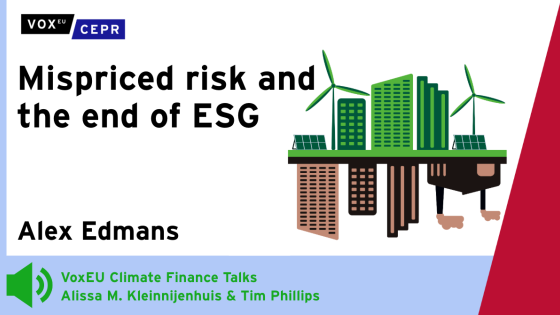Climate scientists and economists have shown widespread agreement that anthropogenic climate change has the potential to cause substantial economic damage, and that taking action to mitigate carbon emissions is essential for reducing the risk of catastrophic effects. Of course, there is scientific uncertainty about the magnitudes of these effects and an active debate about the most appropriate course of action. Some have argued that the uncertainty in the climate science is an argument to delay any response until we know enough to identify the best course of action. However, a recent meta-analysis by the Council of Economic Advisers shows that reaching a climate target is costlier – or even impossible – if policies designed to reach that target begin at a later date. Because a delay results in additional near-term accumulation of greenhouse gases in the atmosphere, delay means that the policy, when implemented, must be more stringent to achieve the given long-term climate target. This additional stringency increases mitigation costs, relative to those that would be incurred under the least-cost path starting today.
The cost of delayed action based on a meta-analysis of 16 studies
We reviewed 16 studies that compare 106 pairs of policy simulations based on integrated climate mitigation models.1 The simulations comprising each pair implement similar policies that lead to the same climate target (typically a concentration target but in some cases a temperature target) but differ in the timing of the policy implementation, nuanced in some cases by variation in when different countries adopt the policy. Because the climate target is the same for each scenario in the pair, the environmental and economic damages from climate change are approximately the same for each scenario. The additional cost of delaying implementation thus equals the difference in the mitigation costs in the two scenarios in each paired comparison. The studies reflect a broad array of climate targets, delayed timing scenarios, and modelling assumptions as discussed below. We focus on studies published in 2007 or later.
In each case, a model computes the path of cost-effective mitigation policies and mitigation costs, constraining the emissions path so that the climate target is hit. Each path weighs technological progress in mitigation technology and other factors that in the beginning generally allow for a less stringent, less costly policy against the costs that arise if mitigation, delayed too long, must be undertaken rapidly. Because the models typically compute the policy in terms of a carbon price, the carbon price path computed by the model starts out relatively low and increases over the course of the policy. Thus a policy started today typically has a steadily increasing carbon price, whereas a delayed policy typically has a carbon price of zero until the start date, at which point it jumps to a higher initial level then increases more rapidly than the optimal immediate policy. The higher carbon prices after a delay typically lead to higher total costs than a policy that would impose the carbon price today.2
The costs of delay in these studies depend on a number of factors, including the length of delay, the climate target, modelling assumptions, future baseline emissions, future mitigation technology, delay scenarios, the participants implementing the policy, and geographic location. More aggressive targets are more costly to achieve, and meeting them is predicted to be particularly costly, if not infeasible, if action is delayed. Similarly, international coordination in policy action reduces mitigation costs, and the cost of delay depends on which countries participate in the policy, as well as the length of delay.
We construct a data set describing each delay cost estimate and information about the simulation. The data include all available numerical estimates of the average or total cost of delayed action from our literature search. Each estimate is a paired comparison of a delay scenario and its companion scenario without delay. To make results comparable across studies, we convert the delay cost estimates (presented in the original studies variously as present values of dollars, percent of consumption, or percent of GDP) to percent change in costs as a result of delay.3 We capture variation across studies and experimental designs using variables that encode the length of the delay in years; the target carbon dioxide equivalent (CO2e) concentration; whether only the relatively more-developed countries act immediately (partial delay); the discount rate used to calculate costs; and the model used for the simulation.4 All comparisons consider policies and outcomes measured approximately through the end of the century. To reduce the effect of outliers, the primary regression analysis only uses results with less than a 400% increase in costs (alternative methods of handling the outliers are discussed below as sensitivity checks), and only includes paired comparisons for which both the primary and delayed policies are feasible (i.e. the model was able to solve for both cases).5 The dataset contains a total of 106 observations (paired comparisons), with 58 included in the primary analysis. All observations in the data set are weighted equally.
Analysis of these data suggests two main conclusions, both consistent with findings from specific papers in the underlying literature. The first is that, looking across studies, costs increase with the length of the delay. Figure 1 shows the delay costs as a function of the delay time. Although there is considerable variability in costs for a given delay length because of variations across models and experiments, there is an overall pattern of costs increasing with delay.
Figure 1. Additional mitigation costs of delay by length

Source: Council of Economic Advisers calculations.
Notes: Data points are percentage increase in mitigation costs from delay and the associated length of delay for a given paired simulation. The scatterplot presents a total of 58 paired delay simulations. The solid line is the regression fit to these data, restricted to pass through the origin.
For example, of the 14 paired simulations with ten years of delay, the average delay cost is 39%. The regression line shown in Figure 1 estimates an average cost of delay per year using all 58 paired experiments under the assumption of a constant increasing delay cost per year (and, by definition, no cost if there is no delay), and this estimate is 37% per decade. This analysis ignores possible confounding factors, such as longer delays being associated with less stringent targets, and the multiple regression analysis presented in the Annex below controls for such confounding factors.
The second conclusion is that the more ambitious the climate target, the greater are the costs of delay. This can be seen in Figure 2, in which the lowest (most stringent) concentration targets tend to have the highest cost estimates. In fact, close inspection of Figure 1 reveals a related pattern – the relationship between delay length and additional costs is steeper for the points representing CO2e targets of 500 ppm or less than for those in the other two ranges. That is, costs of delay are particularly high for scenarios with the most stringent target and the longest delay lengths.
Figure 2. Additional mitigation costs by CO2 concentration target

Notes: Data points are percentage increase in mitigation costs from delay and the associated CO2 concentration target for a given paired simulation. The scatterplot presents a total of 58 paired delay simulations. The solid line is the regression line fit to these data.
Conclusion
This analysis concerned the cost of trying to hit the same climate target with a later start date for the policies. It showed that the cost of achieving a given target would rise by about 40%. This, however, is only one factor to consider in assessing the timing and magnitude of action on climate change. Because CO2 accumulates in the atmosphere, delaying action increases CO2 concentrations. Thus, if a policy delay leads to higher ultimate CO2 concentrations, that delay produces persistent economic damages that arise from higher temperatures and higher CO2 concentrations. Based on the DICE model as reported by William Nordhaus (2013), a delay that results in warming of 3° Celsius above preindustrial levels, instead of 2°, could increase economic damages by approximately 0.9% of global output.6 To put this percentage in perspective, 0.9% of estimated 2014 US Gross Domestic Product (GDP) is approximately $150 billion. The incremental cost of an additional degree of warming beyond 3° Celsius would be even greater. Moreover, these costs are not one-time, but are rather incurred year after year because of the permanent damage caused by increased climate change resulting from the delay.
Moreover, there is considerable uncertainty around all of these estimates – including the possibility of damages significantly greater than assumed in these calculations, potentially as a result of ‘tipping points’ above which climate change becomes a self-amplifying cycle. Climate policy can be thought of as ‘climate insurance’ taken out against the most severe and irreversible potential consequences of climate change. Events such as the rapid melting of ice sheets and the consequent increase of global sea levels, or temperature increases on the higher end of the range of scientific uncertainty, could pose such severe economic consequences as reasonably to be thought of as climate catastrophes. Confronting the possibility of climate catastrophes means taking prudent steps now to reduce the future chances of the most severe consequences of climate change. The longer that action is postponed, the greater will be the concentration of CO2 in the atmosphere and the greater is the risk. Just as businesses and individuals guard against severe financial risks by purchasing various forms of insurance, policymakers can take actions now that reduce the chances of triggering the most severe climate events. And, unlike conventional insurance policies, climate policy that serves as climate insurance is an investment that also leads to cleaner air, energy security, and benefits that are difficult to monetise like biological diversity.
References
Blanford, G J, R G Richels, and T F Rutherford (2009), “Feasible Climate Targets: The Roles of Economic Growth, Coalition Development and Expectations”, Energy Economics 31(supplement 2): S82–S93.
Bosetti, V, C Carraro, and M Tavoni (2009), “Climate Change Mitigation Strategies in Fast-Growing Countries: the Benefits of Early Action”, Energy Economics 31(supplement 2): S14–S151.
Bosetti, V, C Carraro, A Sgobbi, and M Tavoni (2009), “Delayed Action and Uncertain Stabilisation Targets. How Much Will the Delay Cost?”, Climatic Change 96(3): 299–312.
Calvin, K, J Edmonds, B Bond-Lamberty, L Clarke, S H Kim, P Kyle, S J Smith, A Thomson, and M Wise (2009a), “Limiting Climate Change to 450 ppm CO2 Equivalent in the 21st Century”, Energy Economics 31(supplement 2): S107–S120.
Calvin, K, P Patel, A Fawcett, L Clarke, K Fisher-Vanden, J Edmonds, S H Kim, R Sands, and M Wise (2009b), “The Distribution and Magnitude of Emissions Mitigation Costs in Climate Stabilization under Less Than Perfect International Cooperation: SGM Results”, Energy Economics 31(supplement 2): S187–S197.
Clarke, L, J Edmonds, V Krey, R Richels, S Rose, and M Tavoni (2009), “International Climate Policy Architectures: Overview of the EMF 22 International Scenarios”, Energy Economics 31(supplement 2): S64–S81.
Edmonds, J, L Clarke, J Lurz, and J M Wise (2008), “Stabilizing CO2 Concentrations with Incomplete International Cooperation”, Climate Policy 8(4): 355–376.
Gurney, A, H Ahammad, and M Ford (2009), “The Economics of Greenhouse Gas Mitigation: Insights from Illustrative Global Abatement Scenarios Modelling”, Energy Economics 31(supplement 2): S174–S186.
Intergovernmental Panel on Climate Change, Working Group III contribution to the Fifth Assessment Report (IPCC WG III AR5) (2014), Climate Change 2014: Mitigation of Climate Change.
Jakob, M, G Luderer, J Steckel, M Tavoni, and S Monjon (2012), “Time to Act Now? Assessing the Costs of Delaying Climate Measures and Benefits of Early Action”, Climatic Change 114(1): 79–99.
Krey, V and K Riahi (2009), “Implications of Delayed Participation and Technology Failure for the Feasibility, Costs, and Likelihood of Staying Below Temperature Targets – Greenhouse Gas Mitigation Scenarios for the 21st Century”, Energy Economics 31(supplement 2): S94–S106.
Loulou, R, M Labriet, and A Kanudia (2009), “Deterministic and Stochastic Analysis of Alternative Climate Targets under Differentiated Cooperation Regimes”, Energy Economics 31(supplement 2): S131–S143.
Luderer, G, V Bosetti, M Jakob, M Leimbach, J Steckel, H Waisman, and O Edenhofer (2012), “The Economics of Decarbonizing the Energy System – Results and Insights from the RECIPE Model Intercomparison”, Climatic Change 114(1): 9–37.
Luderer, G, R C Pietzcker, C Bertram, E Kriegler, M Meinshausen, and O Edenhofer (2013), “Economic Mitigation Challenges: How Further Delay Closes the Door for Achieving Climate Targets”, Environmental Research Letters 8(3).
Nordhaus, W D (2013), The Climate Casino: Risk, Uncertainty, and Economics for a Warming World, New Haven: Yale University Press.
Richels, R G, T F Rutherford, G J Blanford, and L Clarke (2007), “Managing the Transition to Climate Stabilization”, Climatic Policy 7(5): 409–428.
Tol, R S J (2009), “The Feasibility of Low Concentration Targets: An Application of FUND”, Energy Economics 31(supplement 2): S121–S130.
van Vliet, J, M G J den Elzen, and D P van Vuuren (2009), “Meeting Radiative Forcing Targets under Delayed Participation”, Energy Economics 31(supplement 2): S152–S162.
Annex
Table 1 presents the results of multiple regression analysis that summarises how various factors affect predictions from the included studies, holding constant the other variables included in the regression. The dependent variable is the cost of delay, measured as the percentage increase relative to the comparable no-delay scenario, and the length of delay is measured in decades. Specifications (1) and (2) correspond to Figures 1 and 2, respectively. Each subsequent specification includes the length of the delay in years, an indicator variable for a partial delay scenario, and the target CO2e concentration. In addition to the coefficients shown, specification (4) includes model fixed effects, which control for systematic differences across models, and each specification other than column (1) includes an intercept.
The results in Table 1 quantify the two main findings mentioned above. The coefficients in column (3) indicate that, looking across these studies, a one-decade increase in delay length is on average associated with a 41% increase in mitigation cost relative to the no-delay scenario. This regression does not control for possible differences in baseline costs across the different models, however, so column (4) reports a variant that includes a set of fixed effects for the model used. Including model fixed effects increases the delay cost to 56% per decade. When the cost of a delay is estimated separately for different concentration target bins (column (5)), delay is more costly the more ambitious is the concentration target. But even for the least ambitious target – a CO2e concentration exceeding 600 ppm – delay is estimated to increase costs by approximately 24% per decade. Because of the relatively small number of cases (58 paired comparisons), which are further reduced when delay is estimated within target bins, the standard errors are large, especially for the least ambitious scenarios, so for an overall estimate of the delay cost we do not differentiate between the different targets. While the regression in column (4) desirably controls for differences across models, other (unreported) specifications that handle the outliers in different ways and include other control variables give per-decade delay estimates both larger and smaller than the regression in column (3).7 We therefore adopt the estimate in regression (3) of 41% per decade as the overall annual estimate of delay costs.
One caveat concerning this analysis is that it only considers cases in which model solutions exist. The omitted, infeasible cases tend to be ones with ambitious targets that cannot be met when there is long delay, given the model’s technology assumptions. For this reason, omitting these cases likely understates the costs of delay reported in Table 1.8 Additionally, we note that estimates of the effect of a partial delay (when some developed nations act now and other nations delay action) are imprecisely estimated, perhaps reflecting the heterogeneity of partial delay scenarios examined in the studies.
Table 1. Increased mitigation costs resulting from a delay, given a specified climate target: Regression results

Notes: The table presents ordinary least squares regression coefficients, with each column representing a different regression. For each, the dependent variable is the percent increase in cost from a scenario involving no delay to a scenario involving a delay. Each observation is a comparison of a pair of scenarios with the same climate target, for a total of 58 observations. The regressors represent some of the variables that characterize each paired comparison: the simulated delay, the delay interacted with the concentration target (binned), whether only some countries delayed (partial delay), and the target concentration. The appendix lists all studies from which the data were drawn. The specification in column (1) does not include a constant.
Significant at the: *10% **5% ***1% significance level.
Source: CEA calculations on results from studies listed in appendix.
1 The studies include a series of papers describing an exercise by the Energy Modeling Forum: Loulou et al. (2009), Tol (2009), Gurney et al. (2009), van Vliet et al. (2009), Blanford et al. (2009), Krey and Riahi (2009), Calvin et al. (2009a, 2009b), Russ and van Ierland (2009), and Bosetti et al. (2009), with Clarke et al. (2009) providing an overview of the project. The meta-analysis includes the following studies not associated with this exercise: Jakob et al. (2012), Luderer et al. (2012, 2013), Edmonds et al. (2008), Richels et al. (2007), and Bosetti et al. (2009).
2 Some models explicitly identify the carbon price path that minimises total social costs. These optimisation models always find equal or greater costs for scenarios with a delay constraint. Other models forecast carbon prices that result in the climate target but do not demand that the path results in minimal cost. These latter models can predict that delay reduces costs, and a small number of comparisons we review report negative delay costs.
3 For example, if in some paired comparison delay increased mitigation costs from 0.20% of GDP to 0.30% of GDP, the cost increase would be 50%. Comparisons for which the studies provided insufficient information to calculate the percentage increase in costs are excluded. Also excluded are comparisons that report only the market price of carbon emissions at the end of the simulation, which is not necessarily proportional to total mitigation costs.
4 When measuring delay length for policies with multiple stages of implementation, we count the delay as ending at the start of any new participation in mitigation by any party after the start of the simulation. We also exclude scenarios with delays exceeding 30 years. When other climate targets were provided (e.g. CO2 concentration or global average temperature increase), the corresponding CO2e concentration levels are estimated using conversions from the Intergovernmental Panel on Climate Change, Working Group III AR5 (2014).
5 In the event that a model estimates a cost for a first-best scenario but determines the corresponding delay scenario to be infeasible, the comparison is coded as having costs exceeding 400%. In addition, one comparison from Clarke et al. (2009) is excluded because a negative baseline cost precludes the calculation of a percent increase.
6 Nordhaus (2013) stresses that these estimates “are subject to large uncertainties…because of the difficulty of estimating impacts in areas such as the value of lost species and damage to ecosystems.” (pp. 139–140).
7 The results in Table 1 are generally robust to using a variety of other specifications and regression methods, including: using the percent decrease from the delay case, instead of the percent increase from the no-delay case, as the dependent variable as an alternative way to handle outliers; using median regression, also as an alternative way to handle outliers; and including the discount factor as additional explanation of variation in the cost of delay, but this coefficient is never statistically significant. These regressions use linear compounding, not exponential, because the focus is on the per-decade delay cost not the annual delay cost. An alternative approach is to specify the dependent variable in logarithms (although this eliminates the negative estimates), and doing so yields generally similar results after compounding to those in Table 1.
8 An alternative approach to omitting the infeasible-solution observations is to treat their values as censored at some level. Accordingly, the regressions in Table 1 were re-estimated using Tobit regression, for which values exceeding 400% (including the non-solution cases) are treated as censored. As expected, the estimated costs of delay per year estimated by Tobit regression exceed the ordinary least squares estimates. A linear probability model (not shown) indicates that scenarios with longer delay and more stringent targets are more likely to have delay cost increases exceeding 400% (including non-solution cases). The assumption of bio-CCS technology has no statistically significant correlation with delay cost increase in a censored regression, but is associated with a significantly lower probability of delay cost increases exceeding 400%.









